Electronics
-
- Tech File: Blue Robotics BlueROV2 Marine Technology, Nov 2016 #40
The popularity and availability of aerial quad-copter drones have grown exponentially over the past few years. But, in large part because of the complexities that water penetration poses for electronics, underwater remotely operated vehicles (ROVs) have not experienced that same level of popularity. The technology required to fabricate the components for an ROV to explore beyond a few meters depth has been beyond the capabilities of all but a handful of companies who have mastered the skills. In many cases, those skills have been kept proprietary and the products have demanded high prices. Not long ago you needed well over $10,000 to consider buying even the smallest observation ROV. As mini ROVs have grown in capabilities, so have the prices to the point where a fully-capable mini ROV now costs in excess of $40,000. All that may soon change thanks to companies like Blue Robotics and its newly released BlueROV2.
At first glance, the BlueROV2 is a vectored six thruster ROV, capable of depths of 100 meters in a kit form. But because every bit of the design, from the housings to thrusters to the firmware that controls it, is open to the public, the future and upgrade-ability of the design is virtually unlimited. This not only means that people with technical skills will be able to adapt the BlueROV2 to perform whatever new tasks they might be clever enough to design, but it also means that even the average user is free to source parts and enhancements (such as sonars) from whomever they want. This is an entirely new and potentially powerful approach to ROV design and marketing.What comes with the kitThe kit includes all the thrusters, electronics, housings, frame, flotation, nuts and bolts that you will need to fully assemble a complete ROV. It also includes a tether (of your choice of length) and a topside electronics board. What it does not include are a few basic tools you will need (such as screwdrivers and wire snips), batteries (14.8 VDC LiPo batteries are recommended), a laptop/ tablet to control the ROV, or a monitor to display the video. These are left to the builder to buy and assemble as they wish. Some steps of the construction, such as the waterproof housing penetrators, have already been potted to the cables, while other steps, such assembling the frame and connecting the wires to the various electronics, have been left for the builder to complete.BlueROV2 kit componentsBesides Blue Robotics’ novel approach to delivering this new product, some of the components which make up the kit are themselves equally novel. The motors in the thrusters, for example, are not sealed from water intrusion but instead are open so water can pass freely. The thruster’s construction is mostly from plastics and other inert materials, and what components that are not inert are potted. Surprisingly, even though these thrusters are constantly exposed to salt and debris, long term testing has proven them to be pretty reliable. And considering the cost savings these thrusters afford, it would appear to be a viable approach.Kit optionsBesides various tether length options, you can also choose between the “standard” and “advanced” electronics packages. The standard package uses RS-422 serial communications for control and composite (NTSC / PAL) video. The advanced package uses a tiny, on-board computer (Raspberry Pi), and other electronics to send both HD video and ROV control via Ethernet and a single twisted pair. The standard electronics is similar to how most commercial ROVs are configured. The advanced electronics is something new, offering some exciting new capabilities along with a few additional risks. For this evaluation I built two kits, one with standard electronics and one with the advanced electronics.Building the kitsThe first kit I built was a “beta” version of the “Standard Electronics” kit and so my build was only slightly more complex than what a customer who receives a kit can expect. Assembling the kit primarily involved:- Wiring the ROV side electronics - This step involved mounting two electronics boards to the panel and then connecting them, via screw terminal strips, to the electronic speed controllers (ESC) and thrusters; and then connecting the tether leads to the electronics in the same manner. If you have absolutely no electronics or small tool experience at all, this might take you a bit longer, but it took me about an hour altogether. Most of that time was deciding how to best route the wires so everything would appear neat and easy to repair in the future.
- Assembling the frame - This was one of the easiest parts of the build. The frame is made of HDPE, anodized aluminum and connected with stainless screws. This took less than 30 minutes to complete.
- Change props and mount the thrusters - This was as easy as step 2. The only bit that was more time consuming was swapping the right-hand props in three thrusters to left-hand props. The thruster needs to be disassembled in order to do this, which is not an ideal situation, but performing this task offers two advantages: first, you end up with enough spare props so you have replacement for all six of them, and second, you are taught how to dis- and reassemble the thrusters, a skill worth having with any ROV.
- Mount the housings and route the external wires - This next to last step was very straightforward and did not take long at all to accomplish. The most difficult part (until Blue Robotics sent me a photo for guidance) was deciding how to route the external wires. With a few photos for guidance (which are now included in the kit’s instructions) I finished the ROV end of the build.
- Design and assemble a topside control box - This last step is likely the most challenging part of building the kit, and your options range from simply mounting the topside electronics in a plastic box (which is what I did) to mounting it along with monitor, tablet and other electronics in a proper, waterproof pelican style case (what I plan on doing in the future). In my case, I spent roughly $400 on all the parts and batteries I needed to finish the build to the state seen in the photos.
I built the second kit (with the “Advanced Electronics”) several months after the first. In that time I picked up several kit building tips from other builders and came up with a few of my own. Because this electronics package includes an additional component (the Raspberry Pi computer) building it was a little bit more involved and routing the wires neatly was a bit more challenging than the first kit. As for the software side, I ran into a few minor glitches but thanks to some help on Blue Robotics’ support forums I was able to get things up and running relatively quickly.Building a topside boxOne of the bigger challenges to assembling this kit is designing a box to house the topside electronics. This is one area where it is completely up to you as to how complex or how simple you want to be. I wanted to use “off the shelf” components as much as possible and decided to use a simple, waterproof plastic (NEMA) electronics box and splash resistant bulkhead connectors. While I was at it, I also installed a USB to RS485 converter in the box for use with a sonar I will be installing later.Bench testingAfter assembling the ROV and building a simple topside control unit it was time to install the software and give everything a test. The software that the BlueROV2 uses topside, “QGround Control” is an adaptation of aerial drone software. Likewise, the ROV end hardware it uses is also an adaptation called “ArduSub”. Although initially designed for flying craft, I later learned Blue Robotics modified version worked pretty well, plus because most of the software’s momentum is driven by the aerial drone community, it is constantly being improved. Another benefit of open source software is that I can use it with a wide variety of hardware platforms. The topside controller, for example, can be a Windows, Mac, Linux or even Android computer/tablet. I used a Windows tablet topside and updated the ArduSub firmware via a USB cable connected to the control electronics in the ROV. A few minutes following the instructions and the electronics were ready to operate. I closed up the housing, attached a battery and fired up the ROV and topside controls. Almost immediately, the ROV signaled a few chirps and beeps, telling me it had initialized and was ready to run.When the ROV is first powered up, the compass sensor and topside joysticks needed to be configured. Following the instructions was relatively straightforward. The next step, taken straight from the aerial drone world, was to “arm” the ROV by sliding an icon on the tablet’s screen. By arming the ROV, it was now ready to operate and the thrusters would respond to joystick commands. I tested the thrusters, lights and camera tilt, and all worked as expected. I picked up the ROV and turned it left and right, then tilted it in various directions while watching the attitude and compass displays on the topside tablet computer. Everything seemed to work.Before taking the ROV in the field, I also wanted to give it a test in freshwater. So I gave the water-tight housings a vacuum test, just to make sure they were sealed properly, then put the ROV in a water filled tub. Although the ROV appeared to be functioning correctly on the bench, it was not until I put it in the water that I learned that there were a few settings in the software that I had missed during set up. Some helpful guidance from Blue Robotics and I resolved the issues in short order. I repeated these tests several times until I felt confident that the housings were sealed and I had configured the software properly.In the field testingThe conditions here in coastal North Carolina can be challenging for operating a ROV. Visibility is typically poor, the area has an abundance of snags and obstacles, and is notorious for strong currents. Not the worst conditions a ROV pilot will experience, but certainly not the best either. The day of the test was typical for here, 12 to 15 knots of side shore wind and about 1 knot of current from an outgoing tide.With an assistant to manage the tether, I powered up the ROV and topside controller, checked that everything was sealed properly, then put the ROV in the water. I could immediately see that the BlueROV2 was considerably more buoyant than I would prefer. Although the kit comes with enough additional weight to make it neutrally buoyant, we decided to continue with the test as is. I gave the joysticks some quick commands, the thrusters shot water in the expected directions and the ROV lunged as directed. This ROV has power! I flew the BlueROV2 on the surface with full power, dove to the bottom, watched the instrument displays, flew it sideways against the current and familiarized myself with the controls. At full power the ROV had no problem overcoming the current and responding to my directions. Once back on track, I reduced the thruster gain to 25% and repeated the exercise. Although it was not able to speed against the current, it had no trouble maintaining station.I should note that the BlueROV2 I was testing was running on a version of software that used “fly by wire” (what Blue Robotics calls “Stabilized mode”) by default. Although newer versions of the software includes other flight “modes”, I only tested fly by wire.I continued to test the BlueROV2 at depths of zero to 5 meters and was thoroughly impressed with its performance. The ROV had more power than I was expecting, the fly-by-wire mode worked very well, the heading, attitude and depth sensors all worked as expected and overall the test was completely successful. What few issues I did run into were related to how I had configured my topside equipment. For example, I neglected to set the Windows tablet’s power mode to “always on” so it would go to sleep after 10 minutes of inactivity and disconnect from the ROV. Although a bit of a nuisance, it was no fault of the BlueROV2 and minor issues such as these are to be expected as part of the learning curve when testing a newly completed kit.ConclusionsLooking back at my experiences with the BlueROV2 I have to say it is an amazing piece of equipment. For under $4,000 you have nearly everything needed to assemble a very worthy ROV capable of a wide range of observation class tasks, from water tank to ship hull to fish farm inspections. The BlueROV2 can do it. This is no toy, the components are very well made and the ROV’s capabilities rival more well-known products which cost many times more. It is a kit and some skills are required to complete it. But if you are able to use a few simple hand tools, follow written instructions and install and configure computer software, you have all the skills required to build this kit. I would say the greatest challenges for the builder are the topside controller and dealing with the software/firmware, but even these tasks are not very difficult. And building the kit yields an additional benefit, that when it comes time to repair or maintain the ROV, you will already have all the skills and experience necessary to perform the tasks. I cannot think of a better way for students and budding ROV pilots to become familiar with the technology.Pros- Unrivaled value
- Very good durability
- Good ease of use
- Excellent expand-ability
- Good serviceability
- Excellent thruster power
- Includes features typically found in higher end ROVs, such as vectored thrust and “fly by wire” mode
- Streaming HD video (with the “Advanced Electronics Package”)
Cons- It comes in kit form and requires assembly
- The topside controls are up to the builder to design and fabricate
- Some service procedures (such as replacing a prop) are more involved to complete than I would like
- Runs on batteries, so time on station is not unlimited
- Slight (200-250 ms) lag in HD video stream (with the “Advanced Electronics Package”)
About Blue RoboticsMotivated by a desire to build a better underwater thruster and armed with a degree in engineering, Rustom “Rusty” Jehangir came up with a novel design that turned into a very successful Kickstarter campaign. Now, just two years later, Blue Robotics has grown to a staff of nearly a dozen engineers and technicians working full time designing fresh new approaches to the challenges of ocean exploration.http://www.bluerobotics.comThe AuthorPaul Unterweiser is a retired U.S. Navy officer, USCG licensed master, ROV pilot and, for the last 10 years, president of Marine Simulation, a software company located in North Carolina specializing in developing training simulators for ROV pilot schools and other marine industry applications.http://www.marinesimulation.com(As published in the November/December 2016 edition of Marine Technology Reporter) -
- MN100: ACR Electronics, Inc. Marine News, Aug 2016 #12
The Company: ACR Electronics, Inc. a Drew Marine Company, designs and manufactures a complete line of safety and survival products for the marine industries and various worldwide government agencies. Products include Emergency Position Indicating Radio Beacons, Personal Locator Beacons, ARTEX Emergency
-
- MTR100 '13 Sea-Bird Electronics Marine Technology, Jul 2013 #31
in-house metrology laboratory (water triple-point cells, gallium melting point cells, IAPSO Standard Seawater, 8400B Autosal). The Company: Sea-Bird Electronics manufactures oceanographic CTDs and integrated water sampling systems. The CTDs are designed to measure conductivity, temperature, pressure (depth)
-
- New Electronics from Moxa Maritime Reporter, Sep 2014 #71
The MPC-2240 is a 24-in. flat marine panel computer for marine e-navigation systems. Powered by an Intel Ivy Bridge CPU, the MPC-2240 panel computers are built to handle the heavy graphic computing demands that marine applications such as ECDIS and radar systems require. The MPC-2240 is intended to help
-
- New Stereo from ASA Electronics Maritime Reporter, Jan 2015 #58
Bluetooth enabled capabilities along with a USB input for MP3 devices to give users a wider array of music options while on the water. www.asaelectronics.com (As published in the January 2015 edition of Maritime Reporter & Engineering News - http://magazines.marinelink.com/Magazines/MaritimeReporter
-
- MN100: Larson Electronics LLC Marine News, Aug 2016 #41
The Company: Since 1973 Larson Electronics has manufactured industrial lighting and power distribution products. On LarsonElectronics.com we offer a wide range of products including explosion proof lighting, portable hazardous location lighting, high powered LED lights, hand held 12/24 Volt lighting
-
- Sperry Marine Maintains Leading Position In Competitive Marine Electronics Market Maritime Reporter, Apr 1991 #55
Charlottesville, Va., is home to Sperry Marine Inc., a company which enjoys a world leadership position in an electronics market increasingly dominated by the Japanese. Sperry Marine, which celebrated its 80th anniversary last year, traces its beginnings to the Sperry Gyroscope Company founded in
-
- Hull Electronics Announces New Linear Amplifiers Maritime Reporter, Dec 1990 #48
Hull Electronics Company, San Diego, Calif., recently announced their new family of linear amplifiers and matching power supplies. These broadband solid-state amplifiers are offered in three configurations: 1,000 watts PEP and CW; 1,000 watts PEP, 500 watts CW; 500 watts PRP and CW. The amplifiers
-
- Mackay Communications Wins U.S. N a v y AGOR-23 Electronics Package Maritime Reporter, Jun 1989 #88
Mackay Communications, Inc. of Raleigh, N.C., has been awarded a subcontract to supply the exterior, interior communication as well as the navigational equipment for AGOR-23. In addition, Mackay has contracted to perform the complete turn-key installation of the Navy's newest oceanographic research
-
- Improved TV Antenna From Naval Electronics Maritime Reporter, Jul 15, 1986 #41
— L i t e r a t u r e Available The MK-20 omni-directional TV antenna offered by Naval Electronics Inc. of Tampa, Fla., distributors for Naval Electronics A.B. of Sweden, features three separate band elements with interference filters and an internal, changeable, low-noise amplifier utilizing
-
- Saab Electronics Introduces TankRadar Maritime Reporter, Jan 15, 1986 #33
—Literature Available Saab Marine Electronics AB of Gothenburg, Sweden, has been supplying radar-type level gauging systems for over ten years. Originally, the system's only function was to measure level. However, with the price of crude oil and refined products continually climbing, Saab realized th
-
- Alden Electronics Introduces Tactical Facsimile Receiver Maritime Reporter, Jan 15, 1986 #33
—Free Literature Available Alden Electronics, Inc., Westboro, Mass., has recently introduced the Alden Tactical Facsimile Recorder, Model 9315TR. This new recorder is said to be the only unit designed to receive both teleprinter and facsimile data as a combined capability, making it useful for
-
 )
March 2024 - Marine Technology Reporter page: 43
)
March 2024 - Marine Technology Reporter page: 43pro? ling capability without the need tion of offshore windfarms. GeoPulse 2 introduces new capa- for any dedicated transducers or cabinet of electronics. That bilities that enhance both its operation and data quality. means no additional hardware beyond what is used for the The system is a drop-in
-
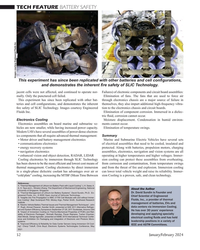 )
January 2024 - Marine Technology Reporter page: 52
)
January 2024 - Marine Technology Reporter page: 52the punctured cell failed. Elimination of fans. The fans that are used to force air This experiment has since been replicated with other bat- through electronics chassis are a major source of failure in teries and cell con? gurations, and demonstrates the inherent themselves, they also impart additional
-
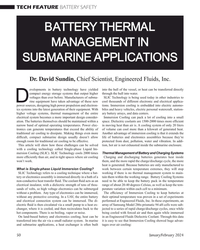 )
January 2024 - Marine Technology Reporter page: 50
)
January 2024 - Marine Technology Reporter page: 50more Another advantage of immersion cooling is that it extends the dif? cult, compact submarine design usually doesn’t allow life of batteries and electronics assemblies because they’re enough room for traditional air cooling to be effective. protected from dust, pollution, water and vibration. In addi- This
-
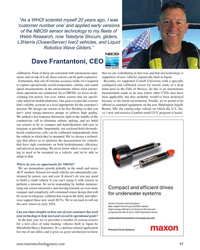 )
January 2024 - Marine Technology Reporter page: 49
)
January 2024 - Marine Technology Reporter page: 49any good to build a small vehicle if you can’t equip it with sensors to perform a mission. So we’re responding by further miniatur- izing our sensor electronics and moving towards an even more compact and completely self-contained sensor design that will be easier to integrate, calibrate hot-swap in the
-
 )
November 2023 - Maritime Reporter and Engineering News page: 15
)
November 2023 - Maritime Reporter and Engineering News page: 15,600 - $159,914 $43,300 $223,537 Third Assistant Engineer $69,944 - $110,479 $34,972 $190,433 Deck Engineer Machinist $50,104 - $56,345 $10,021 $111,267 Electronics Technician $73,643 - $86,493 $36,822 $148,763 Steward Cook $47,351 - $53,229 $23,676 $137,583 Cook Baker $40,722- $49,477 $8,144 $109,346 *Annual
-
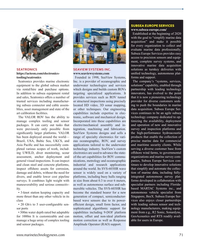 )
September 2023 - Marine Technology Reporter page: 71
)
September 2023 - Marine Technology Reporter page: 71survey systems, and innovative marine data acquisition SEATRONICS SEAVIEW SYSTEMS INC. solutions as turnkey deliveries with https://acteon.com/electronics- www.seaviewsystems.com uni? ed technology, autonomous plat- tooling/seatronics Founded in 1998, SeaView Systems, forms and support. Seatronics
-
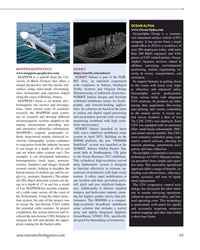 )
September 2023 - Marine Technology Reporter page: 69
)
September 2023 - Marine Technology Reporter page: 69electromag- Traffc Systems and Original Design er effciency and enhanced safety, netic instruments and expertise forged Manufacturing of industrial electronics. OceanAlpha serves professionals along the coast of Brittany, France. NORBIT Subsea designs and develops from various felds with integrated
-
 )
September 2023 - Marine Technology Reporter page: 50
)
September 2023 - Marine Technology Reporter page: 50meticulously sourced raw materials converg- in both micro electro-mechanical systems (MEMS) ing to form ceramics designed with a singular purpose: and electronics, with new drive electronics and im- performance and acoustic clarity. Sensor Technology’s provements to the sensor head. CRH03 is available in
-
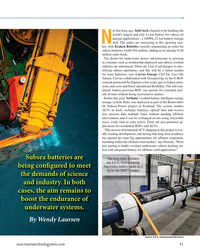 )
September 2023 - Marine Technology Reporter page: 41
)
September 2023 - Marine Technology Reporter page: 41integrated battery for offshore wind applications.” Subsea batteries are The long metal cylinders are A.G.O. Environmental being conf gured to meet Electronics battery packs on a rig for the SWIFT project. the demands of science and industry. In both cases, the aim remains to boost the endurance of
-
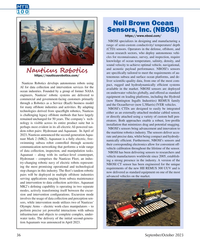 )
September 2023 - Marine Technology Reporter page: 36
)
September 2023 - Marine Technology Reporter page: 36is a fully electric, free- namically ef? cient. Furthermore, NBOSI’s sensors and swimming subsea robot controlled through acoustic their corresponding electronics allow for convenient off- communication networking that performs a wide range vehicle calibration throughout the lifetime of the sensor. of data
-
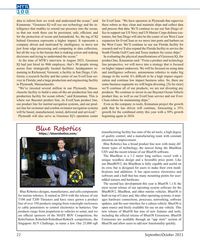 )
September 2023 - Marine Technology Reporter page: 22
)
September 2023 - Marine Technology Reporter page: 22, the BlueBoat is fully capable and useful on its own, but is designed for users to make their own modi- ? cations and additions. It has open-source electronics and software and a hull that has many mounting points for user- added sensors and hardware. The second key development this year is BlueOS 1.1
-
 )
September 2023 - Marine Technology Reporter page: 12
)
September 2023 - Marine Technology Reporter page: 12with the addition ter intensity measurements. Origin 600 possesses power-ef? cient of inertial navigation and optical technologies in recent years, electronics that, combined with its 55Ah internal rechargeable underpinned by ongoing investment in developing technolo- battery, allow for deployments of
-
 )
September 2023 - Marine Technology Reporter page: 2
)
September 2023 - Marine Technology Reporter page: 2MTR 100 September/October 2023 Volume 66 • Number 7 THE 2023MTR100 Company Page Company Page Advanced Navigation 8 Metron 30 A.G.O. Environmental Electronics 42 Nauticus Robotics 36 All American Marine 14 Neil Brown Ocean Sensors, Inc. (NBOSI) 36 Alseamar 10 NORBIT 69 Arctic Rays 56, 76 NOVACAVI
-
 )
September 2023 - Maritime Reporter and Engineering News page: 5
)
September 2023 - Maritime Reporter and Engineering News page: 5,642 - $119,225 $41,321 $223,537 Third Assistant Engineer $66,747 - $82,354 $33,373 $190,433 Deck Engineer Machinist $47,814 - $53,770 $9,563 $111,267 Electronics Technician $70,277 - $82,540 $35,139 $148,763 Steward Cook $45,187 - $50,796 $22,593 $137,583 Cook Baker $38,861 - $47,216 $7,772 $109,346 *Annual
-
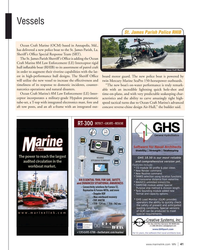 )
June 2023 - Marine News page: 41
)
June 2023 - Marine News page: 41incorporates a military-grade Hypalon pneumatic acteristics and the ability to carve amazingly tight high- tube-set, a T-top with integrated electronics mast, fore and speed tactical turns due to Ocean Craft Marine’s advanced aft tow posts, and an aft a-frame with an integrated out- concave reverse-chin
-
 )
May 2023 - Marine Technology Reporter page: 38
)
May 2023 - Marine Technology Reporter page: 38I could just working in my lab on my own ?Sensors: “Advances that have been made in micro- projects,” Sullivan said, who as the ? gurehead of the in- electronics, optics, acoustics and visualization that you stitute interfaces with politicians, outside organizations and can put on autonomous system is amazing
-
 )
May 2023 - Marine Technology Reporter page: 24
)
May 2023 - Marine Technology Reporter page: 24sen- sion time-of-? ight and average in-situ data collection. ViperFish uses the same sor provides a wealth of data to inform sound velocity data. electronics and ? ight control as the biological studies. The S-PAR sensor is 24 May/June 2023 MTR #4 (18-33).indd 24 6/1/2023 11:48:32 A
-
 )
May 2023 - Marine Technology Reporter page: 21
)
May 2023 - Marine Technology Reporter page: 21repeaters,” said Partridge. in the garage. It was a small house and so the spare room was an Following that Covelya acquired EIVA, a Danish company electronics lab. And my uncle came and lived with us and he was that is very well known in the subsea industry. “[EIVA has a] one of the early technologists
-
 )
May 2023 - Marine Technology Reporter page: 19
)
May 2023 - Marine Technology Reporter page: 19than 50 years ago, John Partridge started Sonardyne in the family home, with ‘a test tank in the garden, a workshop in the garage and an electronics lab in the spare room.’ Much has changed since 1971, and today his son Simon Partridge serves as the chairman of Covelya Group, an umbrella organizati
-
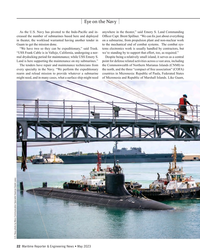 )
May 2023 - Maritime Reporter and Engineering News page: 22
)
May 2023 - Maritime Reporter and Engineering News page: 22Guam to get the mission done. to the mechanical end of combat systems. The combat sys- “We have two so they can be expeditionary,” said Trask. tems electronics work is usually handled by contractors, but “USS Frank Cable is in Vallejo, California, undergoing a nor- we’re standing by to support that effort
-
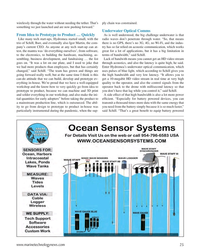 )
March 2023 - Marine Technology Reporter page: 25
)
March 2023 - Marine Technology Reporter page: 25, which works test, the mantra was ‘do everything ourselves’, from software, great for a lot of applications, but it has a big limitation in to the electronics, to building the hardware, machining, as- terms of bandwidth,” said Schill. sembling, business development, and fundraising … the list Lack of
-
 )
January 2023 - Marine Technology Reporter page: 44
)
January 2023 - Marine Technology Reporter page: 44man to be assigned world craftsman’, he paid no attention to to the project. We were based at the Naval clock or calendar when things needed to Electronics Laboratory in San Diego. be done. From being a diver to boat driv- Trieste was unique as there were only er, John was always there. I never saw
-
 )
January 2023 - Marine Technology Reporter page: 41
)
January 2023 - Marine Technology Reporter page: 41systems (MEMS) and electron- Silicon Sensing fect solution for all USV operations.” Silicon Sensing Systems Ltd. is a ics - with new drive electronics and im- Based in the UK, Unmanned Survey leader in silicon MEMS gyroscopes, ac- provements to the sensor head. CRH03 Solution (USS) created the
-
 )
November 2022 - Marine News page: 73
)
November 2022 - Marine News page: 73Names Atkinson AAPA Chairman systems in electrical engineering and Trade group the American Asso- Sustainability VP Crowley has promoted Meaghan electronics, named Jesse Cox as Di- ciation of Port Authorities (AAPA) rector of Automation Sales Engineer- elected a new Chairman of the Board Atkinson as
